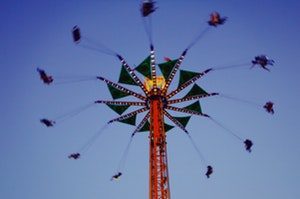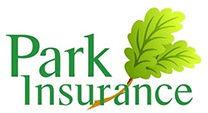Fairs have been touring the UK for hundreds of years, and while modern fairground attractions and rides may be a fairly recent development, ‘all the fun of the fair’ is a part of all our lives and has been for generations.
Fairground attractions are big, noisy, scary, and designed to give us all a thrill. But when things go wrong, a fair or theme park can attract all the wrong kind of attention very quickly. Fairground accidents can range from a splinter from a wooden sign, to catastrophic injuries when things go dramatically wrong with a high-speed ride.
Managers and operators of fairground rides and theme parks take health and safety incredibly seriously – after all, a string of incidents isn’t just bad for the customers who have been injured, it’s bad for the reputation of the park or fair too. By the same token, the Health & Safety Executive has a team of specialist inspectors who hold every ride, stall, and attraction to the highest account.
How dangerous are fairgrounds?
 The trouble is, a fairground or theme park is where we go to enjoy ourselves, so when things go wrong it tends to grab the headlines. However, while the injuries sustained by customers can be horrific, statistically you are more likely to injure yourself falling out of bed than you are falling off a roller coaster.
The trouble is, a fairground or theme park is where we go to enjoy ourselves, so when things go wrong it tends to grab the headlines. However, while the injuries sustained by customers can be horrific, statistically you are more likely to injure yourself falling out of bed than you are falling off a roller coaster.
The truth is that theme parks are far safer than the workplace, or the public highway. According to government statistics, over 165,000 people were injured on the road in 2018, with 1,770 fatalities and over 26,600 serious injuries. The Health & Safety Executive report that in 2018/19 there were over half a million injuries at work, costing the UK economy over £15billion and with a loss of 30.7 million working days.
It’s not just in high-risk situations where you’re likely to suffer an injury either. According to RoSPA, in 2017 3,070 suffered slipper-related injuries, 315 people were hurt in an accident involving a photo frame, and 20,000 people managed to hurt themselves falling out of bed.
When you consider that the number of people hurt at theme parks annually barely reaches 100 across the board, you can see that the headlines you see in the press are not giving you a true representation of the potential hazards of a day out at a theme park.
Why do you need fairground insurance?
Despite the fact that the dangers are wildly overestimated by the tabloids, theme park operators need to cover themselves against potential personal injury claims, and ensure that they have the right kind of insurance. Because of the specific nature of theme parks and fairs, normal insurance isn’t sufficient, so specialist fairground insurance packages have been created specifically for the industry. Here’s a quick run-down of what fairground operators need to think about when it comes to insurance:
- Public Liability Insurance – this will protect you against the financial cost of legal action if an injury compensation claim is brought against an operator. PLI also covers you for damage to property. Injury or damage compensation claims can be incredibly costly, both in the compensation pay-out and for the legal costs that you will incur, so PLI is, in our opinion, an absolute necessity.
- Employer’s Liability cover – even if the employees are your own family or only work for you on a part-time or contracted basis, you must, by law, have Employer’s Liability insurance.
- Cost of liability insurance – as with any insurance deal, the cost of the policy will have a direct bearing on the degree of risk involved. Unusual working environments such as fairground rides and theme park attractions can mean that your insurance costs may be higher than, for example, the insurance you’d need for an office environment. However, the cost of not having insurance could be significantly higher. It will also depend if you have had any previous claims made against you, and what the underwriter determines as the level of risk.
How much liability cover do you need?
 Limits are either based on the amount a single claim would cost, or can cover any number of claims over the period of a year. On average, cover is limited to increments of £1million, £2million, £5million and £10million. How much cover you have will depend on the degree of exposure and how much you’re willing to pay. Cover of £10million will naturally cost more than a £1million policy.
Limits are either based on the amount a single claim would cost, or can cover any number of claims over the period of a year. On average, cover is limited to increments of £1million, £2million, £5million and £10million. How much cover you have will depend on the degree of exposure and how much you’re willing to pay. Cover of £10million will naturally cost more than a £1million policy.
For Employer’s Liability, the statutory minimum policy is £5million, although the actual cover is usually more likely to be £10million.
Other insurance
As well as PLI and Employer’s liability insurance, fairground insurance packages should include other forms of financial protection for operators. Insurance against property and material damage is important, as a broken attraction immediately puts the operator’s livelihood in jeopardy. Insurance against breakdowns, combined with protection against Business Interruption, will mean that while the ride or attraction is out of use, there will still be some financial cushion to protect the operator, so that bills can be paid.
Because many fairground operators move around the country, Goods in Transit and specialist motor insurance are an important part of any fairground insurance package. It is also worth looking at caravan insurance too, to protect living accommodation and personal belongings.
Protecting your takings
Most fairground operators deal almost exclusively in cash, so the risk of theft until the day’s takings can be paid into a bank is high. Business money insurance covers your takings so that if they are lost or stolen, you should be reimbursed by your insurance policy, minimising the impact on your business.
Putting together a bespoke package
The type of fairground insurance cover you go for will depend entirely on your business model, your requirements, and how much you want to invest in your insurance portfolio. Rather than buying each individual insurance policy separately, the best thing to do is to talk to an insurance broker who specialises in tailor-made packages for specific industries. That way, you can be sure that the policy you have is the right one for you.
